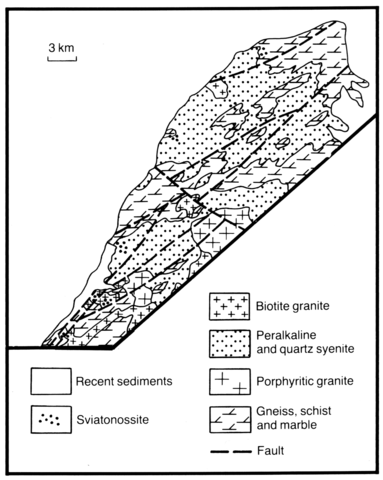stripes
Sited on the eastern shore of Lake Baikal, this intrusion is an irregularly shaped body which extends in a northeasterly direction for 30-35 km, conformably with the enclosing metamorphic rocks. Its width varies from 5 to 17 kilometres and it has an area of about 230 km2. The country rocks, which are Archaean or early Proterozoic, are represented by gneisses, schists, marbles and quartzites. The formation of the intrusion took place in two episodes, the first of which involved emplacement of aegirine-salite syenites and quartz syenites and the second intrusion of biotite granites. Sviatonossites – garnet-bearing alkali syenites of variable composition – are genetically linked with the alkaline syenites and quartz syenites, although they form less than 1% of the area of exposed rocks. Alkali feldspar is predominant in the composition of alkali syenites (45-69%), with plagioclase (15-32%), quartz (7-10%), aegirine-salite (1-4%), hastingsite and biotite. In addition to these minerals the sviatonossites contain about 30% of garnet in which andradite or almandine components are predominant. Compositions of rocks and minerals can be found in Zanvilevich et al. (1985).
ZANVILEVICH, A.N., LITVINOVSKY, B.A. and ANDRE’E V, G.V. 1985. The Mongolian-Transbaikalian alkali-granitoid province (geology and petrology). Nauka, Moscow. 232 pp.

